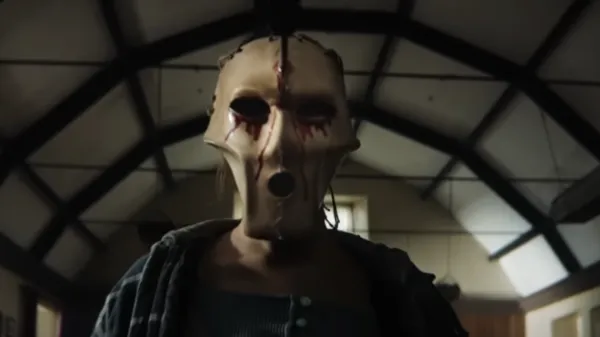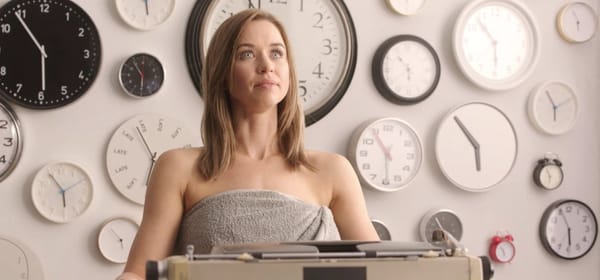28 Years Later
A surprising, existential and experimental new entry into the iconic series that, while sometimes uneven, still provides more than enough juicy meat for horror fans to sink their teeth into.

2002’s 28 Days Later was a game-changer, offering a new, unique perspective on the zombie genre and starting the zombie-movie boom of the early 2000s-2010s. Funnily enough, despite re-igniting the genre, director Danny Boyle and writer Alex Garland hadn’t set out to make a zombie film at all - and, technically speaking, they hadn’t; the undead of 28 Days Later were actually still very much alive, but infected with a highly contagious “rage virus”, and referred to as "the infected" rather than zombies. The infected were more fixated on attacking than feeding, and, atypically for “zombies”, running relentlessly after their prey. While this was not the very first time faster-moving zombies had entered the cultural zeitgeist, it most definitely popularised them, and “fast zombies" , or “sprinters” have since become almost ubiquitous within the genre.
And now, 23 years later, director Danny Boyle and writer Alex Garland have reunited to give us 28 Years Later. Mostly ignoring the events of 2007’s 28 Weeks Later (a serviceable, if less innovative sequel made by Juan Carlos Fresnadillo), it tells the story of a British family living as part of a small community of survivors on Holy Island, a tidal island off the northeast coast of England. The community have managed to survive by fiercely guarding the causeway from the infected who roam on the mainland. 12 year old Spike (Alfie Williams) lives with his father Jamie (Aaron Taylor-Johnson) and mother Isla (Jodie Comer). Isla is suffering from a mystery illness that causes bouts of alzheimer-like confusion; when Jamie tells her he is taking Spike on his first trip to the mainland (seemingly a rite of passage for young men), she is appalled, and deeply distressed, before forgetting a few moments later what has been said. Spike is incredibly worried about his mother, but has been told by his father that there are no doctors anywhere who could help.
I was surprised by how existential, philosophical and downright moving the film often was. Seeing characters struggle to truly reckon with the nuances of death, despite being surrounded by it in such a heightened way, invited reflection on how we in Western society confront the topic. There is a character in the film who is labelled insane for erecting grisly monuments to the dead, yet when we meet him, he is more honest than anyone we have previously encountered, wishing to confront death head on, whilst using non-violent medical methods to protect himself. To the residents of Holy Island, killing the infected is not only necessary, but something to be celebrated, and Jamie brags about Spike's fabricated kills. The survivors hunt the infected by bow and arrow, and Boyle splices the narrative with archival footage of various representations of warfare throughout history, in just one of the many disarmingly abstract filmmaking choices found throughout.
War is the ultimate justification given for killing, and dehumanisation of the enemy is an essential war tactic. Though, when it comes to the infected, there’s no need for external dehumanisation - the interestingly named "rage virus" strips its victims of their humanity, transforming them into relelentless killing machines with only bloodlust on the brain. Though, come to think of it, that does sound pretty human, especially at this current moment in time, as we bear witness to unthinkable death and destruction that is entirely man-made.
But that's sort of what the 28 films have always been about; people, society, and what exactly it is that makes us human. Young Spike struggles at first to kill the infected, despite the threat to his own life, as they look so human, and his father Jamie says something along the lines of “the more you kill, the easier it gets.” In one astonishing sequence, Isla risks her life to help a pregnant infected woman as she gives birth, the two connecting on a primal level through their shared experience of labour. Childbirth is so far the only thing shown to be so all-consuming as to replace in the infected the impulse to kill - in that brief moment, the need to give life outweighs the need to take it.
28 Years Later is the first in the series to be released since modern audiences have experienced our own real-life deadly virus, and it makes for some sobering parallels, not just in the themes of isolation or quarantine, but of community care, too. I remember various versions of the same joke circulating during lockdown; that these unprecedented times had shown us exactly how people would behave in a zombie apocalypse, with one example being the rapper Ice T tweeting in October 2020 that "The people that would lie about a positive Covid test… Are the same ones that would HIDE a Zombie bite."
Interestingly, it was believed by horror experts that the Covid-19 pandemic had contributed to the general public interest in zombie outbreak movies officially ending (having already been on the decline throughout the late 2010's), so it will be interesting to see if this affects audience response to 28 Years Later.
The performances are fantastic across the board, though special mention must go to our young protagonist, 14 year old Alfie Williams as Spike. He is truly incredible, selling every one of the complex and varied emotions his character experiences, and has wonderful chemistry with both Taylor-Johnson and Comer. It's rare to see a child actor carry a film in such a confident way, and is deserving of the utmost praise. I also must commend Raife Fiennes for an incredibly warm performance, in a role he seems to be having a lot of fun with - I went into the film knowing very little of what was to come (thanks in part to that rare gem, a well-made trailer that DIDN'T give away the whole film!) so won't say any more than that.
I realise, perhaps surprisingly for a horror review, that I actually haven’t discussed whether or not it is scary. This is, of course, entirely subjective. As with the first film, I personally found the reflections on the human proclivity for violence and the rumbling reminders of the inevitability of death to be some of the most disturbing ideas presented - but, fear not horror fans, there's also some excellent gore, effective jumpscares, and truly expert moments of tension.
As previously mentioned, the mode of presentation is often experimental; much of the film was shot on an iPhone 15 Max, harkening back to the radical use of digital video cameras on 28 Days Later. In both films, I found the choice to be incredibly effective and unsettling, the lower quality contributing an uneasiness reminiscent of found footage films, and adding a nasty sense of realism to the proceedings. I’m not sure the less traditional elements will work for everyone, both in the presentation and the story itself; the tone often feels uneven, and there are gaps in the narrative clearly waiting to be filled in by the upcoming sequel, 2026’s 28 Years Later: The Bone Temple, shot back-to-back with this film. Without spoiling anything, the ending is completely nuts, and I’m still not sure how I felt about it. It made me laugh, and I admired the audacity to go quite so balls to the wall, but I think it remains to be seen whether it was an effective swing or not.
This is my longest review to date, and yet I still feel I've only just scratched the surface of all of my feelings about 28 Years Later, and what exactly I thought of it. In our current era of reboots, remakes, sequels and requels, where we've grown so accustomed to cash-grabs devoid of any genuine ingenuity and innovation, I'd much rather a film have a unique, risk-taking vision than just go through the motions, even if it sometimes feels slightly incoherent as a result.
While 28 Years Later won't be for everyone, I found it to be an overall hugely entertaining and impressive film, that works more often than it doesn't.




